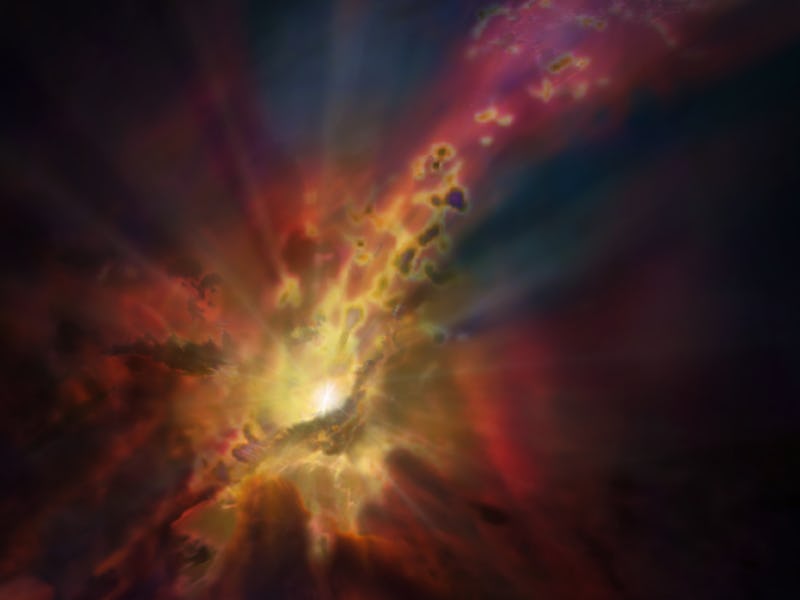Astronomers Found a Black Hole That's Feeding on a Buffet of Icy Cosmic Gas
This is how a black hole gets its lunch on.

Here’s something pretty gnarly to bite into today: there’s a supermassive black hole at the center of a galaxy one billion light-years from Earth, and it’s currently chowing down on a cluster of cold, dense, intergalactic gas.
Using the Atacama Large Millimeter/submillimeter Array (ALMA), a large radio telescope, an international team of astronomers have now made the first direct observation that cold interstellar clouds can coalesce out of hot intergalactic gas and flow off towards a black hole, contributing to its accretion process. The findings are reported in a paper, to be published in the journal Nature on Thursday.
Composite image of Abell 2597 Brightest Cluster Galaxy. The background image (blue) is from the Hubble Space Telescope. The foreground (red) is ALMA data showing the distribution of carbon monoxide gas in and around the galaxy. The pull-out box is the ALMA data of the "shadow" (black) produced by absorption of the millimeter-wavelength light emitted by electrons whizzing around powerful magnetic fields generated by the galaxy's supermassive black hole. The shadow indicates that cold clouds of molecular gas are raining in on the black hole.
Astronomers used to think that supermassive black holes — especially in the largest galaxies — had diets that consisted primarily of ionized gas from the galaxy’s halo. The new observations, by contrast, are evidence that when a black hole is hungry and cosmic weather conditions are right, these hyper dense celestial phenomena have no problem lunching on cold molecular gas.
“Although it has been a major theoretical prediction in recent years, this is one of the first unambiguous pieces of observational evidence for a chaotic, cold rain feeding a supermassive black hole,” said Grant Tremblay, an astronomer with Yale University and lead author on the new paper, in a news release. “It’s exciting to think we might actually be observing this galaxy-spanning rainstorm feeding a black hole whose mass is about 300 million times that of the sun.”
Deep in the heart of the Abell 2597 Brightest Cluster Galaxy, astronomers see a small cluster of giant gas clouds raining in on the central black hole.
The research team stumbled on this incredible discovery while surveying Abell 2597, a bright cluster of about 50 galaxies — the center of which is a massive elliptical galaxy surrounded by hot ionized gas. This gas can cool down, condense, and essentially rain down on the supermassive black hole in quite a similar way that Earth’s humid atmosphere will collect into clouds that precipitate.
In this instance, however, that “rain” jets off at millions of miles per hour. Each cloud of cold gas is more massive than a million suns, and stretches out to tens of light-years across.
Although the ALMA team only detected three clouds of interstellar gas near the supermassive black hole, they believe there are thousands of others in the region. The black hole won’t go hungry for billions of years. In the meantime, scientists hope to continue watching celestial mastication unfold to get a better understanding of exactly how a black hole sucks up matter and grows into bigger monsters.